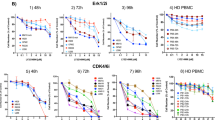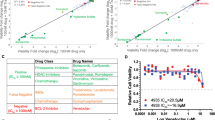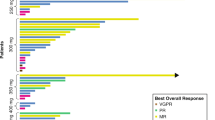Abstract
The phosphatidylinositol 3′-kinase (PI3K) pathway is dysregulated in multiple myeloma (MM); we therefore tested a highly selective class I PI3K inhibitor, GDC-0941, for anti-myeloma activity. Functional and mechanistic studies were first performed in MM cell lines, then extended to primary MM patient samples cultured in vitro. GDC-0941 was then assessed as a single agent and in various combinations in myeloma tumor xenograft models. We show p110 α and β are the predominant PI3K catalytic subunits in MM and that a highly selective class I PI3K inhibitor, GDC-0941, has robust activity as a single agent to induce cell cycle arrest and apoptosis of both MM cell lines and patient myeloma cells. Mechanistic studies revealed an induction of cell cycle arrest at G0/G1, with decreased phospho-FoxO1/3a levels, decreased cyclin D1 and c-myc expression, and an increase in the cell cycle inhibitor, p27kip. Induction of apoptosis correlated with increased expression of the pro-apoptotic BH3-only protein BIM, cleaved caspase 3 and cleaved poly (ADP-ribose) polymerase (PARP). In vitro, GDC-0941 synergized with dexamethasone (Dex) and lenalidomide (combination index values of 0.3–0.4 and 0.4–0.8, respectively); in vivo GDC-0941 has anti-myeloma activity and significantly increases the activity of the standard of care agents in several murine xenograft tumor models (additional tumor growth inhibition of 37–53% (Dex) and 22–72% (lenalidomide)). These data provide a clear therapeutic hypothesis for the inhibition of PI3K and provide a rationale for clinical development of GDC-0941 in myeloma.
This is a preview of subscription content, access via your institution
Access options
Subscribe to this journal
Receive 50 print issues and online access
$259.00 per year
only $5.18 per issue
Buy this article
- Purchase on Springer Link
- Instant access to full article PDF
Prices may be subject to local taxes which are calculated during checkout





Similar content being viewed by others
References
Kyle RA, Rajkumar SV . Multiple myeloma. N Engl J Med 2004; 351: 1860–1873.
Hallek M, Bergsagel PL, Anderson KC . Multiple myeloma: increasing evidence for a multistep transformation process. Blood 1998; 91: 3–21.
Rajkumar SV, Buadi F . Multiple myeloma: new staging systems for diagnosis, prognosis and response evaluation. Best Practice Res 2007; 20: 665–680.
Kyle RA, Rajkumar SV . Treatment of multiple myeloma: a comprehensive review. Clin Lymphoma Myeloma 2009; 9: 278–288.
Kawauchi K, Ogasawara T, Yasuyama M, Otsuka K, Yamada O . Regulation and importance of the PI3K/Akt/mTOR signaling pathway in hematologic malignancies. Anticancer Agents Med Chem 2009; 9: 1024–1038.
Khwaja A . PI3K as a target for therapy in haematological malignancies. Curr Top Microbiol Immunol 347: 169–188.
Zollinger A, Stuhmer T, Chatterjee M, Gattenlohner S, Haralambieva E, Muller-Hermelink HK et al. Combined functional and molecular analysis of tumor cell signaling defines 2 distinct myeloma subgroups: Akt-dependent and Akt-independent multiple myeloma. Blood 2008; 112: 3403–3411.
Baumann P, Mandl-Weber S, Oduncu F, Schmidmaier R . The novel orally bioavailable inhibitor of phosphoinositol-3-kinase and mammalian target of rapamycin, NVP-BEZ235, inhibits growth and proliferation in multiple myeloma. Exp Cell Res 2009; 315: 485–497.
McMillin DW, Ooi M, Delmore J, Negri J, Hayden P, Mitsiades N et al. Antimyeloma activity of the orally bioavailable dual phosphatidylinositol 3-kinase/mammalian target of rapamycin inhibitor NVP-BEZ235. Cancer Res 2009; 69: 5835–5842.
Kawauchi K, Ogasawara T, Yasuyama M, Otsuka K, Yamada O . The PI3K/Akt pathway as a target in the treatment of hematologic malignancies. Anticancer Agents Med Chem 2009; 9: 550–559.
Harvey RD, Lonial S . PI3 kinase/AKT pathway as a therapeutic target in multiple myeloma. Future Oncol (London, England) 2007; 3: 639–647.
Podar K, Chauhan D, Anderson KC . Bone marrow microenvironment and the identification of new targets for myeloma therapy. Leukemia 2009; 23: 10–24.
Chanan-Khan AA, Borrello I, Lee KP, Reece DE . Development of target-specific treatments in multiple myeloma. Br J Haematol 151: 3–15.
Gera J, Lichtenstein A . The mammalian target of rapamycin pathway as a therapeutic target in multiple myeloma. Leuk Lymphoma 2012 52. 1857–1866.
Feldman ME, Shokat KM . New inhibitors of the PI3K-Akt-mTOR pathway: insights into mTOR signaling from a new generation of Tor Kinase Domain Inhibitors (TORKinibs). Curr Top Microbiol Immunol 347: 241–262.
Hoang B, Frost P, Shi Y, Belanger E, Benavides A, Pezeshkpour G et al. Targeting TORC2 in multiple myeloma with a new mTOR kinase inhibitor. Blood 116: 4560–4568.
Bain J, Plater L, Elliott M, Shpiro N, Hastie CJ, McLauchlan H et al. The selectivity of protein kinase inhibitors: a further update. Biochem J 2007; 408: 297–315.
Munugalavadla V, Berry L, Chen YH, Deshmukh G, Drumond J, Du C et al. A selective PIM kinase inhibitor is highly active in multiple myeloma: Mechanism of action and signal transduction studies. ASH 2010; 116: 4084.
Ebens A, Berry L, Chen YH, Deshmukh G, Drumond J, Du C et al. A selective PIM kinase inhibitor is highly active in multiple myeloma: The biology of single agent and PI3K/AKT/mTOR combination activity. ASH 2010; 116: 3001.
Ikeda H, Hideshima T, Fulciniti M, Perrone G, Miura N, Yasui H et al. PI3K/p110{delta} is a novel therapeutic target in multiple myeloma. Blood 116: 1460–1468.
Jou ST, Carpino N, Takahashi Y, Piekorz R, Chao JR, Carpino N et al. Essential, nonredundant role for the phosphoinositide 3-kinase p110delta in signaling by the B-cell receptor complex. Mol Cell Biol 2002; 22: 8580–8591.
Raynaud FI, Eccles SA, Patel S, Alix S, Box G, Chuckowree I et al. Biological properties of potent inhibitors of class I phosphatidylinositide 3-kinases: from PI-103 through PI-540, PI-620 to the oral agent GDC-0941. Mol Cancer Ther 2009; 8: 1725–1738.
Folkes AJ, Ahmadi K, Alderton WK, Alix S, Baker SJ, Box G et al. The identification of 2-(1H-indazol-4-yl)-6-(4-methanesulfonyl-piperazin-1-ylmethyl)-4-morpholin -4-yl-thieno[3,2-d]pyrimidine (GDC-0941) as a potent, selective, orally bioavailable inhibitor of class I PI3 kinase for the treatment of cancer. J Med Chem 2008; 51: 5522–5532.
Drexler HG, Matsuo Y . Malignant hematopoietic cell lines: in vitro models for the study of multiple myeloma and plasma cell leukemia. Leuk Res 2000; 24: 681–703.
Yasui H, Hideshima T, Richardson PG, Anderson KC . Novel therapeutic strategies targeting growth factor signalling cascades in multiple myeloma. Br J Haematol 2006; 132: 385–397.
Anderson KC, Carrasco RD . Pathogenesis of myeloma. Annu Rev Pathol 2011; 6: 249–274.
Chou TC, Talalay P . Quantitative analysis of dose-effect relationships: the combined effects of multiple drugs or enzyme inhibitors. Adv Enzyme Regul 1984; 22: 27–55.
Zhao L, Wientjes MG, Au JL . Evaluation of combination chemotherapy: integration of nonlinear regression, curve shift, isobologram, and combination index analyses. Clin Cancer Res 2004; 10: 7994–8004.
Lee T, Yao G, Nevins J, You L . Sensing and integration of Erk and PI3K signals by Myc. Plos Comput Biol 2008; 4: e1000013.
O’Brien C, Wallin JJ, Sampath D, GuhaThakurta D, Savage H, Punnoose EA et al. Predictive biomarkers of sensitivity to the phosphatidylinositol 3' kinase inhibitor GDC-0941 in breast cancer preclinical models. Clin Cancer Res 16: 3670–3683.
Ismail SI, Mahmoud IS, Msallam MM, Sughayer MA . Hotspot mutations of PIK3CA and AKT1 genes are absent in multiple myeloma. Leuk Res 2009; 34: 824–826.
Peterson TR, Laplante M, Thoreen CC, Sancak Y, Kang SA, Kuehl WM et al. DEPTOR is an mTOR inhibitor frequently overexpressed in multiple myeloma cells and required for their survival. Cell 2009; 137: 873–886.
Rahmani M, Anderson A, Habibi JR, Crabtree TR, Mayo M, Harada H et al. The BH3-only protein Bim plays a critical role in leukemia cell death triggered by concomitant inhibition of the PI3K/Akt and MEK/ERK1/2 pathways. Blood 2009; 114: 4507–4516.
Zhang J, Choi Y, Mavromatis B, Lichtenstein A, Li W . Preferential killing of PTEN-null myelomas by PI3K inhibitors through Akt pathway. Oncogene 2003; 22: 6289–6295.
Dib A, Gabrea A, Glebov OK, Bergsagel PL, Kuehl WM . Characterization of MYC translocations in multiple myeloma cell lines. J Natl Cancer Inst 2008; 39: 25–31.
Munugalavadla V, Vemula S, Sims EC, Krishnan S, Chen S, Yan J et al. The p85alpha subunit of class IA phosphatidylinositol 3-kinase regulates the expression of multiple genes involved in osteoclast maturation and migration. Mol Cell Biol 2008; 28: 7182–7198.
Acknowledgements
We thank Genentech chemistry group for providing materials, Andy Polson for critical reading of the manuscript, Jeff Wallin and Kyle Edgar for helpful discussions, the IVCC team for technical support, and the especially the patient donors who helped further these work in hopes of helping others.
Author information
Authors and Affiliations
Corresponding author
Ethics declarations
Competing interests
VM, SM, DS, CD, LB, GD, YY, MB, LS, LF and AE are employees of Genentech, Inc., MC and PB do not have any conflict of interest.
Additional information
Supplementary Information accompanies the paper on the Oncogene website
Rights and permissions
About this article
Cite this article
Munugalavadla, V., Mariathasan, S., Slaga, D. et al. The PI3K inhibitor GDC-0941 combines with existing clinical regimens for superior activity in multiple myeloma. Oncogene 33, 316–325 (2014). https://doi.org/10.1038/onc.2012.594
Received:
Revised:
Accepted:
Published:
Issue Date:
DOI: https://doi.org/10.1038/onc.2012.594
Keywords
This article is cited by
-
Potential theranostics of circulating tumor cells and tumor-derived exosomes application in colorectal cancer
Cancer Cell International (2020)
-
Novel agents in the treatment of multiple myeloma: a review about the future
Journal of Hematology & Oncology (2016)
-
PIK3CA dependence and sensitivity to therapeutic targeting in urothelial carcinoma
BMC Cancer (2016)
-
Signaling Pathways and Emerging Therapies in Multiple Myeloma
Current Hematologic Malignancy Reports (2016)
-
Overcoming inherent resistance to histone deacetylase inhibitors in multiple myeloma cells by targeting pathways integral to the actin cytoskeleton
Cell Death & Disease (2014)



